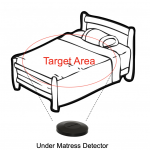Bed Occupancy Sensor
Sensor IT’s Bed Occupancy Sensors are non-wearable devices, and operate using a Doppler radar that detects micro-movements of the human body such as a heartbeat or breathing. Doppler technology uses the frequency spectrum within mmWave, and in our case, we are using radar with a frequency of 60 GHz. Importantly, mmWave frequencies are non-ionising. In addition, the energy emitted by these devices is significantly lower than that used by mobile phones, or Wireless networks such as WIFI, which means they are intrinsically safe to use.
The frequency detected by the Doppler radar is used to measure velocity and the data is transmitted to the user interface. Care home personnel can then use the information displayed to monitor residents’ health and safety by assisting those whose movement is undetected. This helps overall healthcare management in healthcare facilities.

The Bed Occupancy Sensor can be installed either overhead (above the bed) or below the mattress. We actually recommend for the sensors to be installed below the mattress, as in this location they are out of sight and the chances of false detections are also minimised. It is, in our view, a much more elegant deployment than when it is in plain view for everyone to see. Finally, by being attached to the bed frame means the sensor moves with the bed when the furniture in the room is rearranged, or simply the room layout changes.
Hospital patients and care home residents falling out of bed is a far more common occurrence than many people might realise. According to a report published in the UK in 2021 ((https://www.data.gov.uk/dataset/74aa0d1c-6a76-4c57-bf3b-b4155822d307/national-audit-of-inpatient-falls-2020), nearly a quarter of a million hospital inpatients experienced falls from their beds within a single year. This alarming statistic highlights that such incidents are not isolated or rare—they represent a widespread and serious concern in healthcare settings. These falls can lead to a range of consequences, from minor bruises to severe injuries such as fractures or head trauma, especially among elderly or vulnerable individuals. Beyond the immediate physical harm, bed falls can also prolong hospital stays, increase healthcare costs, and contribute to a decline in overall patient well-being. As such, preventing bed-related falls should be considered a priority in the management and design of patient care environments.
Bed Occupancy Sensor Production
These devices are wholly manufactured in-house by Sensor IT as we value creating sustainable and innovative solutions from the ground up. We intend to deploy them in the long run in public healthcare facilities.